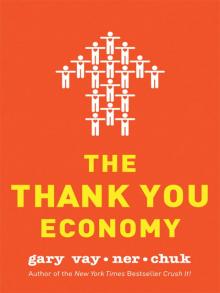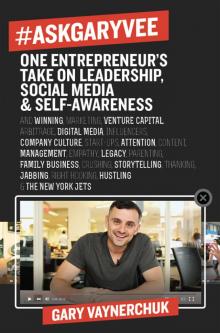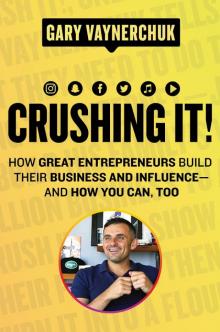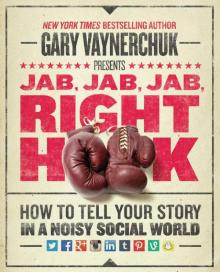- Home
- Gary Vaynerchuk
Jab, Jab, Jab, Right Hook Page 11
Jab, Jab, Jab, Right Hook Read online
Page 11
Clumsy hashtag: Where they really went wrong is in choosing their hashtag. At the time that I first reviewed this tweet, a click on #guarding showed that security guards use it, and so do sixteen-year-old basketball players. Hollister doesn’t own the “guarding” concept, and so they should have chosen a more distinct hashtag to bring attention to the meme.
Busy visuals: Then there’s the photo they used. It’s colorful, but small and cluttered. There are too many things vying for your eye and the text is cramped. Hollister’s story could have been told through a tweet in a shorter, more streamlined way with a single up-close picture of a pair of pretty boys’ faces with the hashtag beneath.
SURF TACOS: Feeding New Platforms
This isn’t the greatest jab of all time, but I thought it would be a good idea to show some lightweight moves that won’t revolutionize the social media world but do provide some examples of easy things you can do so you don’t feel pressured to create masterpiece after masterpiece.
Good cross-pollination: Surf Taco has a respectable following on Twitter of about 6,400 followers. They have about 500 on Instagram. By pushing an Instagram picture on Twitter, they’re wisely using their bigger pool of followers to increase the size of their smaller one. This is a strategy more people need to follow, although pushing Instagram to Twitter worked better before competition between the two meant that Twitter cut off seamless Instagram integration, so that it would no longer load natively. However, when you are trying to develop a following on a new platform, whether it’s Pinterest, Instagram, Snapchat, or whatever we’ll see in the future, it’s important to use the platform where you have the most data to drive traffic to the new one (three years ago I was telling people to use their email service to drive traffic to Facebook). Siphoning data from place to place is an excellent strategic move to build awareness of your presence on a new platform.
Appropriate aesthetic: Surf Taco also clearly understands the aesthetic of Instagram. This isn’t a particularly artistic or exciting shot, but at least they’re not using a stock photo or a glossy product picture. It’s a casual, natural scene from a real place, and based on the solid engagement it received, even from a relatively small community, it resonated with followers.
They also knew enough about Twitter users to include a hashtag, and a good one, too, though it might have been smart to include one or two broad hashtags, like “#baseball,” to try to earn even greater visibility.
All in all, not a bad play by a small New Jersey business.
CHUBBIES SHORTS: It’s All About the Voice
Ultimately, success in social media boils down to three things: understanding the nuances of your platform, using a distinct voice, and driving your business goals. Chubbies does all three in this, one of my favorite pieces of micro-content in this book.
The most powerful thing about this piece is the voice, which carries through this content from beginning to end. It’s young, wry, irreverent, and entertaining—exactly what the demo is looking for when it comes to Twitter. The tweet itself shows that the brand understands the nuances of this platform. It is brief and spare, nothing but two hashtags that link to a meme that offers humorous suggestions of things that are superior, in this case a cat named Pablo Picatso, to their competitor’s product, cargo shorts. It’s a ridiculous and funny comparison. Now, why did this meme work, when Hollister couldn’t get much traction with #guarding? The hashtag. No one but Chubbies has any reason to create hashtags like #CargoEmbargo or #SOTO—Skies Out Thighs Out—so they have complete ownership. The hashtags are distinct enough to gain cachet to those people who decide to run with them. Chubbies didn’t blow it by linking out to a product page, either.
You want to see ROI on social media? Tell a story that’s good enough to get people to buy stuff. My creative team and I were impressed with this brand’s commitment to upholding a strong voice and its attention to the nuances of the platform. That raised our brand awareness, which got us talking about the shorts, which made us a little obsessed, which led me to buying eleven pairs, one for each member of the team. The VaynerMedia team’s thighs will be out in Chubbies style.
BULGARI US: A PR Company Gets in Its Own Way
When my parents came to this country in the late 1970s, they became obsessed with Elizabeth Taylor. In fact, I’m confident that my grandmother’s first two words in English were “Elizabeth Taylor.” So I have affection for the icon, which is why I hate to see her poorly treated. This was surely a great event, melding two high-end, luxury brands. Unfortunately, Bulgari didn’t commit to honoring Ms. Taylor online as much as they did offline.
Live tweeting events can get obnoxious when the only value the tweets bring are to the PR company trying to get impressions. That’s what’s going on with this tweet. The picture is so weak, an intern hiding behind a potted plant could have taken it. We could have chosen to criticize any of the twenty-three tweets they put out throughout the day but this one deserves special attention for being particularly terrible. It’s hard to even see what’s going on. Try this: Turn this page back, then quickly return to this page. Can you tell what you’re looking at in a split second? You have to click on the link and look on a big PC screen, and then stick your nose close to that screen, to get an idea of what the sumptuous flower arrangements on the table looked like. But no one is going to make that effort, nor should they, because the picture holds zero value, either to the consumer or to the brand.
I do give Bulgari credit for mentioning the catering company. It shows heart for an international brand to publicly acknowledge a company with a 200-person Twitter following.
NETFLIX: Simplicity Works
This is a perfectly executed jab, launched just days after Netflix announced that fifteen episodes of the long-awaited fourth season of the cult television show hit Arrested Development would air exclusively on their platform. Its success lies in packing a lot of power into a very simple package.
The picture is a clear reference to the show’s season-three finale, when a character quits the family company. And the copy is timely and clever. “Hey Brother,” a line frequently heard on the show, gave Netflix the perfect way to ride the hashtag wave of National Sibling Day. For the record, almost every day of the year has been designated an unofficial national day of something-or-other—use this knowledge well.
AMC: Calls to Nowhere
This tweet feels schizophrenic—“Retweet if you love The Rock!NO!Watch this video!NO!Buy tickets!” In 140 characters, AMC managed to make three calls to action. That’s an accomplishment, but not one to be proud of. When you’re asking for three calls to action, you’re asking for no calls to action. The customer spotting this mishmash of links and short text coming through a mobile screen had to have been extremely confused. There’s just no way to know where to focus our attention first. AMC often makes some strong social media moves, but unfortunately, much like the GI Joe movies, this one sucked.
NBA: Smart Partnering
The NBA threw a great right hook here to raise awareness of their partnership with Kia and their joint MVP awards. Every decision shows finesse, from keeping the tweet streamlined and clear, to capitalizing the word “you” to help connect with their community. They repeatedly reinforced the Kia brand, beginning with the inclusion of the Kia Twitter handle in the tweet, to framing the NBA.com landing page—which opens with an article and photo announcing LeBron James as the winner of the MVP Kia Awards—in bold red with the Kia logo. I don’t know for sure that Kia paid the NBA for this fully integrated social media drive, but if they did, it was money well spent.
GOLF PIGEON: Confusing Quantity with Quality
If you’re just starting out or you have a small consumer base and you want to trendjack to amplify your reach, one strategic and valuable way to do it is to use Twitter’s ad platform and buy a keyword that will turn your tweet into the first or second result when a consumer searches a term on Twitter. But one thing I’m always stressing is that it’s not the quantity of impres
sions that counts, it is the quality. You can tweet out to a million people, but if your tweet stinks or is irrelevant to them, it’s entirely possible that of that million people who saw your tweet, a half million of them now hate your product or your brand. The day this tweet went out, Lionel Messi, the best soccer player in the world, must have scored his seven thousandth spectacular goal of the season, and his name was trending. Golf Pigeon must have thought that if soccer fans were talking about Messi, they might like to talk about golf, too. Wait, that doesn’t even make sense. Theoretically, soccer and golf can sometimes overlap. I guess. I mean, sure, they’re both sports. One explanation for this strange pairing might be that sometimes Twitter pushes promoted tweets into related hashtags to deliver more impressions. Golf Pigeon might not have chosen to promote against #messi, in which case they’re off the hook. But if they did, they didn’t do themselves any favors. It might have been a smart move to try to garner some crossover awareness this way back in the 1980s, when there were a limited number of channels on which to reach sports fans. But in today’s targeted world, there’s no reason to waste dollars marketing to a soccer community about golf. The company would have seen a lot more upside had they waited for the Masters and tripled down on trending topics that were more aligned with their brand and their community.
HOLIDAY INN: A One-Way Conversation
So many public replies, so little value. Retweeting nice things said about you to your entire consumer base has only one name. It’s called bragging. Doing it nonstop is called obnoxious. From April 21 to April 23, 2013, Holiday Inn spent most of its time retweeting the nice things people said about them to all thirty thousand of their fans, when instead they should have spent five minutes forming a deeper relationship with the fans who took the time to praise them. By the way, any time a brand of this size is following more people than follow it back, it speaks to just how severely they are misusing their Twitter account. It’s a sign that they’re gaming the system—following people in hopes that they will follow back. It’s a cheap tactic.
Poor Holiday Inn is taking the heat in this book, but retweeting fan praise is a mistake that thousands of brands make every day, probably because PR companies love to tell their clients that it’s a smart move. I’m telling you, it isn’t. Retweets of this nature have little to no value to anyone who follows you. It’s truly poor form, not to mention incredibly boring for your followers.
FIFA: Breaking News
As I’ve said, businesses that want to compete in social media today need to embrace a dual identity. They will of course be the purveyors of a product or service, but they must also learn to act like a media company. This post illustrates exactly what that looks like. EA Sports FIFA is a video game for soccer lovers. But with this post, the brand shows that it understands that if it is to compete, it must become much more.
The tweet went out to announce that the teams for the UEFA Champions League semifinals had just been confirmed. Five or six years ago, soccer fans would have found this news out when it appeared at the bottom of the ESPN screen, and anyone who missed it would have read about it the next day in the newspaper. But on this day, a video game broke the news, if not to the world, then at least to anyone who followed it on Twitter. What did this jab do for the brand? The number of retweets was more than five hundred. Anyone who got their news here first turned right around and retweeted it to all of their followers. All those fans and their followers gave EA Sports FIFA the news credit. In addition, the brand reaped the rewards of nice levels of engagement, brand awareness, brand affinity, and probably tens if not hundreds of new followers—all by leading the media conversation around their genre. Those new followers represent many people who might be receptive when EA Sports FIFA throws a right hook in the form of an offer, coupon, or other call to action.
TACO BELL: Getting It
This one is impressive, a truly awesome example of skillful trendjacking. #ThoughtsInBed was trending. Taco Bell jumped in and offered their answer in their typical snarky, cheeky, edgy voice. Obviously their efforts resonated, because out of only about 430,000 followers, they received almost 13,000 retweets. Why did the tweet perform so well? Because Taco Bell did exactly what they were supposed to do—they respected the platform, and they talked in the same voice as their consumer. They understand that the Twitter demo is a youth demo, and if you look at their stream, you can see that day in, day out, they’re reaching out to their followers and consistently making contact, building enormous brand affinity in the process. They deserve the highest level of praise I can offer: They get it.
SKITTLES: Hashtag Heaven
A lot of examples in this book make me want to cry, but this one made me smile. It probably made you smile, too. It’s cute, it’s funny, it sounds like a Skittles lover. The really smart thing they did, though, was to link their micro-content to an evergreen hashtag. It’s a hashtag that never dies, its jokey, effervescent content ensuring that it remains relevant to anyone looking for a little humor. If Skittles keeps tweeting out micro-content like this, it has a long, exciting social media life ahead of it.
CHRIS GETHARD: Hard Work That Will Pay Off
Comedians are an interesting demo on Twitter because an ungodly number of them use it to preview jokes, spread awareness, and throw right hooks like asking people to buy their DVD or come to a show. This upcoming comedian out of Brooklyn, however, has hit on the right formula. He tells jokes, of course, but he also retweets and engages, responding to and talking to fans and letting them know that he’s paying attention and appreciating the time they take to let him know what they think. He’s putting in a ton of effort that will result in big residual gains once he has a special or he decides to start throwing more right hooks.
TWITTER: Clueless
Twitter helped my career in a huge way, so it’s with a heavy heart that I have to criticize them for their stunning lack of engagement. They are in a constant state of push, putting out self-serving announcement after announcement, and make zero effort to build community. On June 6, 2013, they were in full-on brag mode, announcing their new partnership with WPP. That the platform itself has no idea how to natively storytell proves that we are still living in the early days of the grand social media timeline. Twitter has the capability to listen to people talk all day long. When it first bought Vine and millions of people were tweeting raves about the new product, why couldn’t it even muster up the occasional “Thank you”? How could the marketing team not realize the importance of establishing an emotional connection with its users? If they had, maybe some of the people who flocked to Instagram after it launched video sharing might have stayed loyal to Vine, instead of sending it into a downward spiral. The world is emotional. If Twitter itself is not listening and reaching out on Twitter, how can they expect anyone to feel strongly about the platform? I have a lot of friends at Twitter and I’m curious to hear their opinions when they read this critique. I’m sure they’ll have plenty to say.
SPHERO: Nerding It Up
I love this in a big way. It’s a perfect example of a brand that understands its audience and how to tell its story. They understand exactly who would buy a ball controlled by an iPhone. They used a video from a BuzzFeed link, which shows they speak their demo’s native tongue. They get the audience, the medium, the language, the story. Even someone who didn’t belong to the targeted demo would think this is cool.
Many start-ups struggle to tell good stories because instead of building community, they’re focusing on fund-raising and getting an article about themselves published in TechCrunch. It’s hard for a new business to strike the right balance among so many competing priorities. Sphero deserves kudos for managing to do it when so many others put it off. Truly, this is a perfect execution.
FLEURTY GIRL: Flirting with Brilliance
A lot of people reading this book are small business owners with one-store locations. Fleurty Girl has five stores, but that’s still small, and the owner’s commitment to her community, both online a
nd in-store, is impressive. Born and bred in New Orleans, owner Lauren Thom throws around acronyms like NOLA; she knows about the peach festival in Ruston; she retweeted to a New Orleans Saints player—she’s speaking the native language. She probably hasn’t built up a huge base yet, but she’s working hard toward it. I wish more local businesses would put her kind of energy into their media. There are ways she could add a little more spice and flair to her tweets to increase her retweet value. She could add hashtags, for example, to ignite emotions or laughs. When she tweeted, “I love peaches,” an appropriate hashtag might have been #peachesfillthebelly. You need to do anything you can to get people to smile and burn a slightly deeper impression in your consumer’s mind. Instead of wishing Darren Sproles a happy birthday, she could have looked up his age and matched it to the Saints player who wore that number during the 2012 season, so that the greeting becomes something a little more memorable, such as “Happy Ryan Steed!” Something like that would have been fun. I think she’ll get there.
SHAKESPEARE’S PIZZA: Delicious Local Flavor
I’m happy to praise yet another small business that has made a strong commitment to putting out good micro-content, and has a talented writer creating their copy, too. Pay attention—the third tweet seems like a simple response to Earth Day, but look at the clever hashtag. That hashtag shows that this company gets the psyche of a Twitter user, that it understands that it’s those little moments that make consumers go “Ha!” that compel them to retweet to friends and put your brand in their feeds. Shakespeare’s Pizza could have paid for a banner ad to get an impression, but no one would have cared.

 The Thank You Economy
The Thank You Economy Crush It!
Crush It! #AskGaryVee
#AskGaryVee Crushing It! EPB
Crushing It! EPB Jab, Jab, Jab, Right Hook
Jab, Jab, Jab, Right Hook